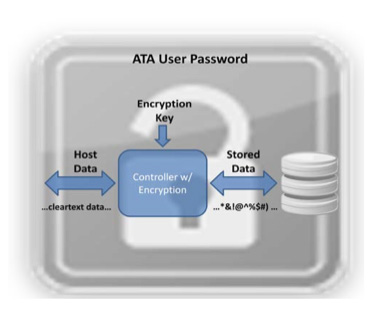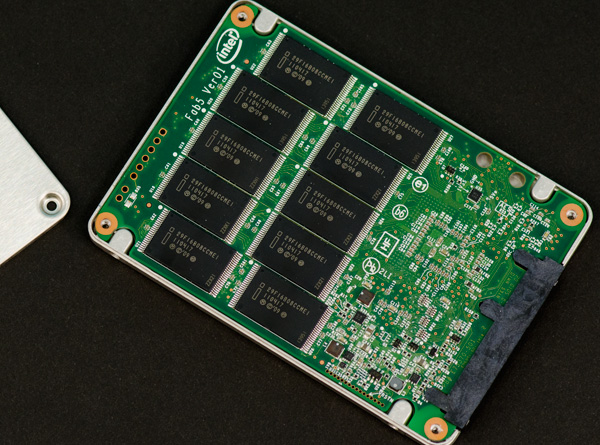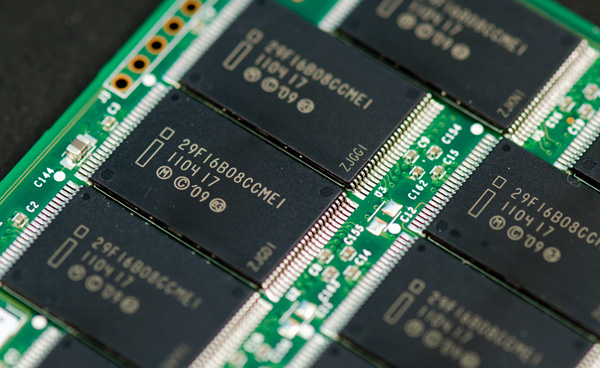The Intel SSD 320 Review: 25nm G3 is Finally Here
by Anand Lal Shimpi on March 28, 2011 11:08 AM EST- Posted in
- IT Computing
- Storage
- SSDs
- Intel
- Intel SSD 320
Spare Area and Redundant NAND
Intel's controller is a 10-channel architecture and thus drive capacities are still a little wonky compared to the competition. Thanks to 25nm NAND we now have some larger capacities to talk about: 300GB and 600GB.
Intel sent a 300GB version of the 320 for us to take a look at. Internally the drive has 20 physical NAND devices. Each NAND device is 16GB in size and features two 64Gbit 25nm 2-bit MLC NAND die. That works out to be 320GB of NAND for a drive whose rated capacity is 300GB. In Windows you'll see ~279GB of free space, which leaves 12.8% of the total NAND capacity as spare area.
Around half of that spare area is used to keep write amplification low and for wear leveling, both typical uses of spare area. The other half is for surplus NAND arrays, a RAID-like redundancy that Intel is introducing with the SSD 320.
As SandForce realized in the development of its controller, smaller geometry NAND is more prone to failure. We've seen this with the hefty reduction in rated program/erase cycles since the introduction of 50nm NAND. As a result, wear leveling algorithms are very important. With higher densities however comes the risk of huge amounts of data loss should there be a failure in a single NAND die. SandForce combats the problem by striping parity data across all of the NAND in the SSD array, allowing the recovery of up to a full NAND die should a failure take place. Intel's surplus NAND arrays work in a similar manner.
Instead of striping parity data across all NAND devices in the drive, Intel creates a RAID-4 style system. Parity bits for each write are generated and stored in the remaining half of the spare area in the SSD 320's NAND array. There's more than a full NAND die (~20GB on the 300GB drive) worth of parity data on the 320 so it can actually deal with a failure of more than a single 64Gbit (8GB) die.
Sequential Write Cap Gone, but no 6Gbps
The one thing that plagued Intel's X25-M was its limited sequential write performance. While we could make an exception for the G1, near the end of the G2's reign as most-recommended-drive the 100MB/s max sequential write speed started being a burden(especially as competing drives caught up and surpassed its random performance). The 320 fixes that by increasing rated sequential write speed to as high as 220MB/s.
You may remember that with the move to 25nm Intel also increased page size from 4KB to 8KB. On the 320, Intel gives credit to the 8KB page size as a big part of what helped it overcome its sequential write speed limitations. With twice as much data coming in per page read it's possible to have a fully page based mapping system and still increase sequential throughput.
Given that the controller hasn't changed since 2009, the 320 doesn't support 6Gbps SATA. We'll see this limitation manifest itself as a significantly reduced sequential read/write speed in the benchmark section later.
AES-128 Encryption
SandForce introduced full disk encryption starting in 2010 with its SF-1200/SF-1500 controllers. On SandForce drives all data written to NAND is stored in an encrypted form. This encryption only protects you if someone manages to desolder the NAND from your SSD and probes it directly. If you want your drive to remain for your eyes only you'll need to set an ATA password, which on PCs is forced by setting a BIOS password. Do this on a SandForce drive and try to move it to another machine and you'll be faced with an unreadable drive. Your data is already encrypted at line speed and it's only accessible via the ATA password you set.

Intel's SSD 320 enables a similar encryption engine. By default all writes the controller commits to NAND are encrypted using AES-128. The encryption process happens in realtime and doesn't pose a bottleneck to the SSD's performance.
The 320 ships with a 128-bit AES key from the factory, however a new key is randomly generated every time you secure erase the drive. To further secure the drive the BIOS/ATA password method I described above works as well.
A side effect of having all data encrypted on the NAND is that secure erases happen much quicker. You can secure erase a SF drive in under 3 seconds as the controller just throws away the encryption key and generates a new one. Intel's SSD 320 takes a bit longer but it's still very quick at roughly 30 seconds to complete a secure erase on a 300GB drive. Intel is likely also just deleting the encryption key and generating a new one. Without the encryption key, the data stored in the NAND array is meaningless.
The Test
| CPU |
Intel Core i7 965 running at 3.2GHz (Turbo & EIST Disabled) Intel Core i7 2600K running at 3.4GHz (Turbo & EIST Disabled) - for AT SB 2011, AS SSD & ATTO |
| Motherboard: |
Intel DX58SO (Intel X58) Intel H67 Motherboard |
| Chipset: |
Intel X58 + Marvell SATA 6Gbps PCIe Intel H67 |
| Chipset Drivers: |
Intel 9.1.1.1015 + Intel IMSM 8.9 Intel 9.1.1.1015 + Intel RST 10.2 |
| Memory: | Qimonda DDR3-1333 4 x 1GB (7-7-7-20) |
| Video Card: | eVGA GeForce GTX 285 |
| Video Drivers: | NVIDIA ForceWare 190.38 64-bit |
| Desktop Resolution: | 1920 x 1200 |
| OS: | Windows 7 x64 |













194 Comments
View All Comments
Drag0nFire - Monday, March 28, 2011 - link
I have read with interest the comments in previous SSD articles. Actually, though, I am specifically interested in the longevity characteristics of this drive being discussed today. I was surprised to see no mention in the article.If the longevity of the Intel SSD 320 has been discussed previously, I apologize for wasting your time.
Anand Lal Shimpi - Monday, March 28, 2011 - link
The 320 (as well as Crucial's m4) arrived while I was away at CTIA last week - I got back Friday morning. That gave me a minimal amount of time to get everything tested before today's NDA. As a result, about five pages got cut out of the 320 review - one of them talked about write amp and exactly what you're asking for. Soon :)Take care,
Anand
Drag0nFire - Tuesday, March 29, 2011 - link
Thanks so much. You guys are the best!Mr Perfect - Monday, March 28, 2011 - link
I'm surprised no one has mentioned the Crucial M4 (AKA C400?) numbers in the benchmarks. Is this old news, or did they just slip in there without anyone noticing. :)Termie - Monday, March 28, 2011 - link
Intel is sending around $530 300GB drives to bench against the current crop of $200 120GB drives. As Anand rightly pointed out, the 300GB drive has completely different specs than the smaller drives. Unlike SandForce, which seems to provide similar performance across sizes, Intel's new drives cannot substitute for each other in performance.I'm guessing very few people will actually buy a $530 drive at this point (even $450 was a hard sell a year ago for the 160GB G2). There are just too many $200 alternatives, and these probably significantly outperform Intel's $200 G3.
crimson117 - Monday, March 28, 2011 - link
I wish the article was a little more clear about this - the first comparison mentioned is "Intel SSD 320 300GB vs. Corsair Force F120 [120GB]" and Anand immediately concludes that it proves the Intel Controller is faster.crimson117 - Monday, March 28, 2011 - link
Note Ryan's comment in another thread:"Both the 120GB Vertex 2 and 300GB i320 are fully populated - each has all of their NAND channels in use. Intel does have a lane count advantage (10 vs. 8), but that's a design difference rather than how the SSD is populated. Thus on an architectural level it's fair to compare the controllers, as we're looking at the performance of both when they're fully populated and the architecture is not unnecessarily bottlenecked.
"Now at equal capacities this wouldn't necessarily be the case. Intel did not provide us with a smaller SSD, which is why Anand said "We also don't have a good idea of how much slower the smaller capacity drives perform in our benchmarks at this point.". It's safe to assume a 120GB i320 won't be fully populated and that it will have lower performance as a result. How much? We don't know."
tonyn84 - Monday, March 28, 2011 - link
Man, I was waiting for these to come out before trying to pick up a larger drive but there's no cost benefit. The 256gb C300 is starting to look very good, going to keep an eye on those prices now.crimson117 - Monday, March 28, 2011 - link
Anand,"all indications pointed to it being faster than drives based on SandForce's SF-1200 controller. And it is..."
Is it really fair to put a 300GB Intel 320 drive against a 120GB SF-1200 drive and conclude the Intel's new controller is faster?
My understanding is that larger SSD's generally perform faster than smaller SSD's, particularly in Write operations, because they have more NAND to write across at once.
How would the 120GB model Intel 320 stand up to a Vertex 2 120GB, when it doesn't have the NAND chip quantity advantage?
Thanks,
crimson117
crimson117 - Monday, March 28, 2011 - link
EDIT: I just saw this on the final page."We also don't have a good idea of how much slower the smaller capacity drives perform in our benchmarks at this point."
That should be mentioned as a caveat on the first page's "Intel SSD 320 300GB vs. Corsair Force F120 [120GB]" comparison chart (if you even keep that chart at all). That chart really doesn't provide a useful comparison when you consider the size advantage of the Intel drive.